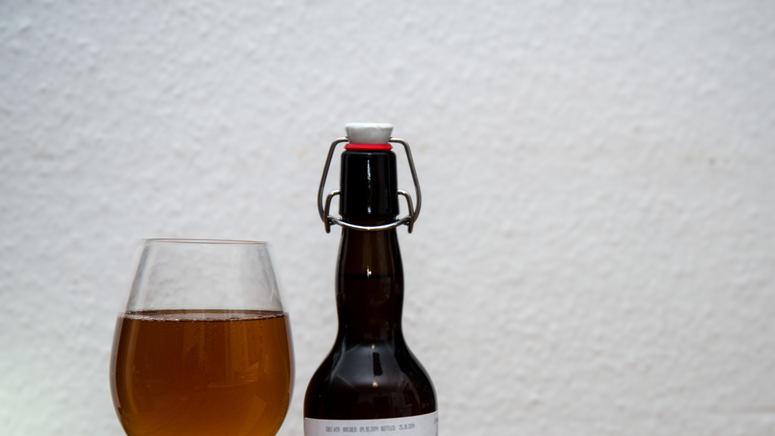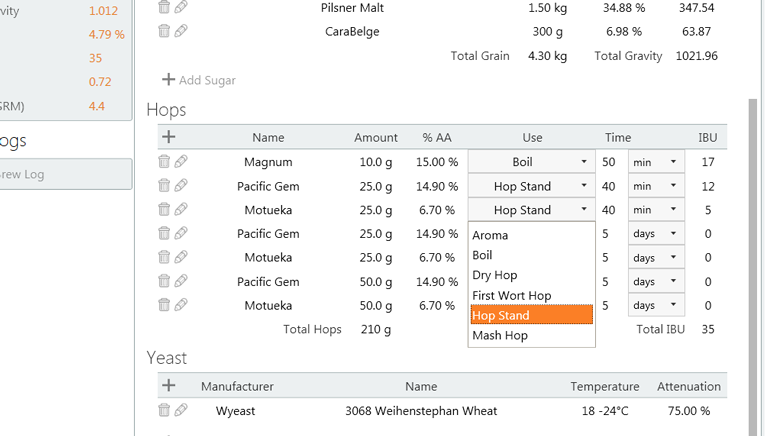Calculated Bitterness

I've spent the last week or so planning my last two beers of this year. One will be a Berliner Weisse (my first attempt at the style) and the other a New Zealand hopped weizen. One of the features I've been working to add to my Brew Designer application for some time now has been IBU calculation for hop stands and mash hopping. I'm planning to use both of the two methods in these last beers of 2014 (mash hopping in the no-boil Berliner and a hop stand in the weizen), so I thought I'd write a little of what I've learned about these techniques. Hop stands and mash hopping contribute some bitterness to beer, but the lower temperatures involved in both mean that the bittering effect is much lower than during the boil. The reason for using both techniques is to maximise the extraction of aromatic compounds from the hops. These compounds tend to be very volatile and so tend to be lost during a long boil.
Bitterness in beer is primarily the result of iso-alpha acids extracted from hops. Hops contain varying amounts of alpha acids, which are not significantly bitter, but which, when heated, are isomerised to iso-alpha acids, which are intensely bitter. The amount of alpha acid in hops ranges from a low of around 2% by weight in old-world varieties like Saaz, to over 15% in newer, high-alpha varieties such as Magnum or Summit. The rate of isomerisation increases with temperature and rapidly falls below significant levels at temperatures below boiling. I wanted to add logic to the application to allow me to determine the amount of bitterness contributed by mash hopping and hop stands.

In mash hopping hops are, as the name suggests, added to the mash, rather than to the boil. Due to the lower temperatures alpha acids in the hops are isomerised at significantly lower rates than during the boil, resulting in substantially lower bitterness. Interestingly, it appears that the aromatic compounds extracted from the hops during mash hopping survive the boil and into the final beer. Mash hopping is also a way of adding hops to beers such as Berliner Weisse which are not boiled.
For a hops stand, hops are added to the wort after the boil and the wort is allowed to stand without being cooled for anything from 10 minutes to overnight. The wort temperature is typically somewhere between 90°C and 70°C. These lower temperatures mean that many of the volatile aromatic compounds in the hops are retained in the wort and thus in the resulting beer.
Utilisation
Essentially what I wanted to find out was how alpha acid utilisation (the proportion of total alpha acids from the hops to make it into the final beer) varies with temperature. This turns out to be a fairly difficult question to get an exact answer to. There is some research into this (see for example this) but it's not entirely clear to me how to translate the results obtained in such, closed-system studies, to the real world. What most sources seem to agree on is that the utilisation at mash hopping temperatures (~ 60 - 70°C) is somewhere around 20% of what you would get during the boil and at the 70 - 80°C range perhaps 30% of boil utilisation. I use the Tinseth formula in Brew Designer, and so until I come up with more reliable numbers I simply adjust my utilisation figure to either 1⁄5 or 1⁄3 of that for the boil to account for the lower utilisation. This isn't a hugely reliable calculation, but as my IBU calculations are probably pretty imprecise and as most people would probably struggle to distinguish a difference of a few IBU one way or another, it should allow me to make some rough estimate of bitterness generated by these hopping methods.